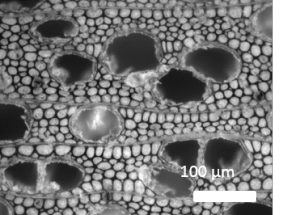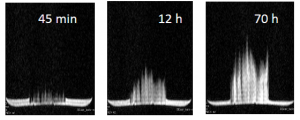Understanding the mechanisms of liquid transfer in wood
Advisors: Philippe Coussot (NAVIER), Sabine Caré (NAVIER), Denis Courtier-Murias (NAVIER)
Brief summary:
The objective of this study is to understand the mechanisms of liquid water transfers in wood. Focus is made on poplar samples. We carried out a series of tests of imbibition with samples of different sizes, which allowed understanding that the longitudinal transfers can be divided in elementary transfers through the channel between two successive concentric tree rings. The original point is the study of these systems with MRI.
- The water penetrates in capillaries of different sizes with different timings.
- A critical finding is that with another liquid type but with the same viscosity the penetration can be much faster.
- Spontaneous water imbibition in wood is slow due to the adsorption of liquid films as bound water in the cell-walls. The dynamics of imbibition in wood appears to be mainly governed by the longitudinal progression of bound water in the sample.
- Synchrotron images confirm that the adsorption of bound water in the cell walls governs the process: it momentarily damps wetting then allows further advance when the walls are saturated.


Figure 1: Dark-field microscopy image of the transversal cross-section: structure of wood with vessels and fibers (left) – View of the water distribution in a 2D section of the sample (right).
Publications:
Zhou M., Caré S., Courtier-Murias D. , Faure P., Rodts S., Coussot P. (2018) Magnetic resonance imaging evidences of the impact of water sorption on hardwood capillary imbibition dynamics , Wood Science and Technology, DOI: 10.1007/s00226-018-1017-y
